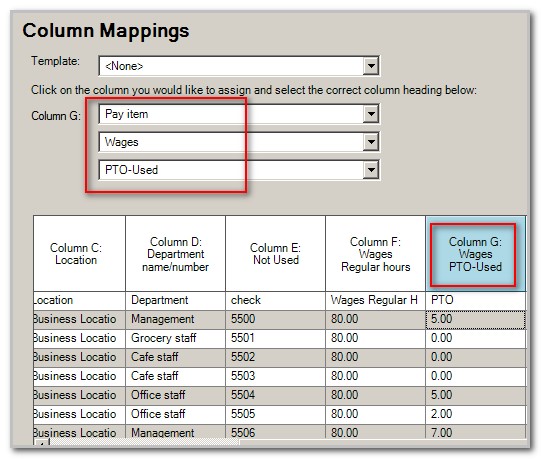We moved!
Help articles have been migrated to the new Help and Support. You can find help for your products and accounts, discover FAQs, explore training, and contact us!
This article provides answers to frequently asked questions about using the time entry spreadsheet import.
Yes. Tips are pay items and are displayed just like all the other pay items. They do not need to be mapped separately.
Yes.
- If the employee’s pay item calculation type is Salary, map employee name, ID, location, (department if needed).
- If the employee’s pay item calculation type is Salary – Hours sensitive, map employee name, ID, location and hours worked.
Things to keep in mind:
- If you have a temporary rate change for a salaried employee, map the amount to Pay item, NameOfPayItem, Pay item override amount. The amount will be paid to the salaried employee for that payroll cycle, leaving the rate as is in the Setup > Employees screen.
- If you map a rate change to Pay item, NameOfPayItem, Rate for a salaried employee, it will change the associated pay rate in the Payroll Items tab of Setup > Employee. Example, if you import a rate of $1500 for an employee that is paid weekly, the rate in their employee record will be updated to $1500 and their next check will be calculated at $28.85 ($1500 / 52 weeks)

Actions > Enter Batch Payroll screen: You cannot map check numbers in the Actions > Enter Batch Payroll Checks screen. The check number is assigned during the printing process. You would need to delete, void, or reverse the checks and re-enter them or reprocess the batch.
Actions > Enter Batch Handwritten Payroll Checks screen: The Actions > Enter Batch Handwritten Payroll Checks screen provides a column for mapping the check number during spreadsheet import. If the check has not been marked as cleared, you can change the check number using the Actions > Enter Transactions Screen.
No, currently this option is not available. This is currently a suggestion in the Idea Incubator. Consider voting on this idea!
Gross amounts. If the employee’s pay item has a calculation type of Salary, import gross amount. If the employee’s pay item has a calculation type of Salary – Hours sensitive, import the hours. If the employee’s pay item has a calculation type of Hourly, import the hours.
Vacation hours should be listed under the Accruable Benefits column, rather than the Regular column. First, you map it to the pay item, then the actual description of the pay item, and then to the name of the accruable benefit, as in the example below.

Verify that the payroll item exists and is active. You can change the payroll item in the spreadsheet to match the payroll item used by the employee. Or, if necessary, add a new payroll item for the employee. Keep in mind that the names must match exactly, and they are case-sensitive.
Verify that the location and/or department exist for that client. Remember that the names of the locations and departments in the spreadsheet must exactly match those specified in the application for the selected client for the import to work correctly. The names are case-sensitive.





